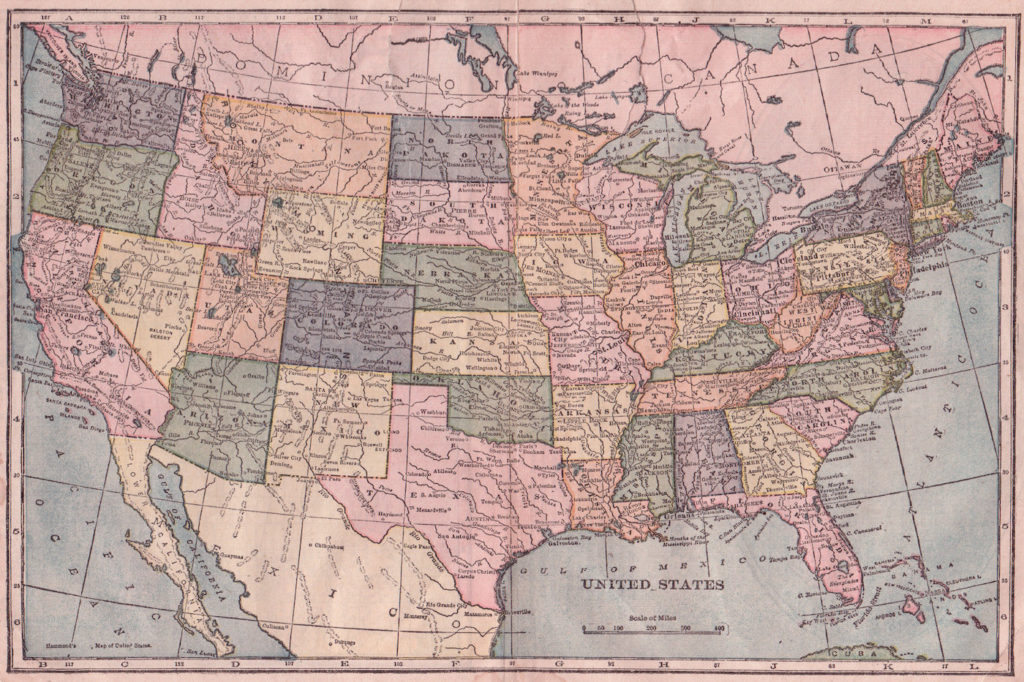I suspect that most courses on constitutional law share the weaknesses of the one I took in law school. Covering relatively few topics with little depth, they focus on what is likely to appear on the bar exam. To their credit, my courses did pique the interest of those who wanted to learn more about specific constitutional topics, and my school did offer courses that took a deeper dive into those questions. But even so, instruction in constitutional law, understood in the most general sense of the term, is severely lacking in U.S. law schools. It barely scratches the surface.
This problem is aggravated by courses’ exclusive focus on the United States Constitution. They virtually ignore America’s other fifty constitutions: the state constitutions.
The interest of citizens in state constitutional law pales in comparison to that for the more politically appealing federal constitution. But state constitutional law is an important subject that has evolved alongside federal constitutional law. Some states, like my state of Pennsylvania, even include state constitutional law on their bar exams and have elaborated a methodology for presenting arguments about it in cases (about which you can read more here).
State constitutions have major repercussions for criminal law, since most criminal cases are heard in the state courts. Even in my own exclusively civil practice, state constitutional law comes up in interesting ways. One of the first cases I faced involved a unique provision of the Pennsylvania Constitution that provides real estate tax exemptions to certain veterans. The federal constitution has no similar provision and nothing to say on this question.
Start your day with Public Discourse
Sign up and get our daily essays sent straight to your inbox.The interest of citizens in state constitutional law pales in comparison to that for the more politically appealing federal constitution. But state constitutional law is an important subject that has evolved alongside federal constitutional law.
Nevertheless, state constitutions have received some scholarly attention. Justice William Brennan’s important 1977 article in the Harvard Law Review, for example, invited citizens to explore protecting individual rights through state constitutions, rather than solely through the federal constitution. Robert F. Williams, Erwin Chemerinsky, James A. Gardner, Ken Gormley, and others have also given attention to state constitutional law.
In his 2018 book 51 Imperfect Solutions, Chief Judge Jeffrey S. Sutton of the U.S. Sixth Circuit Court of Appeals made a new contribution to this literature. There he explored individual rights protections through the two “stories” of the federal constitution and a selection of state constitutions. Here I would like to explore his new book, Who Decides? States as Laboratories of Constitutional Experimentation, published in October, in which he compares and contrasts structures of power in the federal and state constitutions.
Judicial Review
Sutton’s book covers a lot of ground: judicial review, gerrymandering, unitary versus fractured executives, and other topics. After identifying a topic, he sketches the “federal story” of how the U.S. Constitution handles it, then explores how a sampling of states have also done so, highlighting similarities, divergences, and the unique experience of parallel governance. Sometimes the stories are not merely parallel; very often, federal constitutionalism causes changes in the states, and vice versa.
The first story Sutton tells is the story of judicial review.
When we talk about judicial review, the story typically begins in 1803 with Marbury v. Madison, in which Chief Justice John Marshall determined that the Supreme Court could declare a congressional statute unconstitutional. Judicial review is either celebrated or decried, often depending on whether one likes the results it produces. It continues to rub many people the wrong way, like legal philosopher Jeremy Waldron, who has argued against the entire concept as undemocratic.
But judicial review did not begin with Marbury. Long before, in England’s famous Dr. Bonham’s Case of 1610, Lord Edward Coke declared an Act of Parliament void for being contrary to “common right and reason, or repugnant, or impossible to be performed.” This is sometimes considered to be the origin of judicial review in Anglo-American law.
Judicial review was also happening in America before Marbury—among the states. Sutton relates three pre-Marbury cases in which state judges exercised forms of judicial review to overturn state legislation: one from Virginia (1782), one from New York (1784), and one from North Carolina (1787). These cases, Sutton argues, demonstrate a consensus among Americans at that time that “superior laws trumped inferior laws.” He suggests that this view may have come from the founding generation’s universal distrust of power, including the power of legislatures that typically are regarded as the public’s voice.
However, Americans also agreed that, in order for a court to overrule an inferior law, it needed to be clearly inconsistent with the superior law. Judicial review was legitimate only if “judges deployed conventional tools of interpretation in construing constitutions and . . . invalidate[d] a statute only if a clear conflict arose between the two.”
Sutton’s book is not simply a history lesson, though. He includes in it sections that offer his own guidance on “how to judge.” He acknowledges a place for deference to the legislature—the principle of constitutional avoidance—but notes that deference is not always a good starting point, especially when statutes are ambiguous. In those cases, he suggests, judges should presume that the statute has a clear meaning, try to discern what the legislators must have meant, and then defer to that presumed meaning.
Constitutional Structure as Protection for Individual Rights
It is fitting that Who Decides? begins with judicial review because, ultimately, it is a book about power, specifically the different methods states have used to control the power of government through its fundamental structures.
In law school, some of my most passionate classmates could hardly wait to get through the drier classes on federal power structures and into more politically interesting questions of individual rights. Yet, as every law student learns, governmental structure is just as important for protecting individual rights as politically enumerated rights—if not more important.
Consider the public statement of Justice Antonin Scalia in 1988 at the announcement of the Supreme Court’s ruling in Morrison v. Olson, from which Justice Scalia alone dissented:
To many people, it may seem that this case is of some political interest but . . . not likely now or in the future to have any proximate effect upon their lives or the lives of their children. It does not, after all, involve freedom of speech, freedom of the press, freedom of religion, or any of the wonderful guarantees of our Bill of Rights. That is wrong. In the dictatorships of the modern world, Bills of Rights are a dime a dozen. What makes ours work is a governmental structure, a constitution of government. . . . That structure was designed to prevent any excessive governmental power, which is always the first threat to liberty[’s] coalescing.
Morrison v. Olson concerned whether Congress, under Article II of the Constitution, had the power to create an independent counsel. Justice Scalia dissented on the grounds that the U.S. Constitution did not empower Congress, a legislature of enumerated powers, to establish an independent counsel outside the control of the executive branch. Such an independent counsel would, in Scalia’s opinion, violate the separation of powers, and power matters.
Sutton explores the same case in Who Decides? He uses it to illustrate a federal government structure (the unitary executive) that differs from some state governmental structures. Many state constitutions extend democratic checks on power well beyond those of the federal constitution, creating fragmented executives (in which governors, lieutenant governors, and attorneys general run on separate ballots), judicial elections, and amendments by referendum. These matters continue to be important today. Pennsylvania, for instance, recently amended its constitution by referendum to constrain the governor’s powers in times of emergencies.
However, regarding referenda and other means that make it easy to amend state constitutions, Sutton warns that these checks may create more dangers than they avoid. After all, the “people” are just as capable of abusing power (by a tyranny of the majority) as their representatives are.
Many state constitutions extend democratic checks on power well beyond those of the federal constitution, creating fragmented executives (in which governors, lieutenant governors, and attorneys general run on separate ballots), judicial elections, and amendments by referendum.
To Start Local, Begin with Your State’s Constitution
Who Decides? is not just a lesson in what the federal Constitution can learn from the states, but a reminder of the bodies of state constitutional law available to us that we usually forget. As Sutton notes, state constitutions are powerful vehicles for the public’s participation in their own government, and we have a responsibility to use them. He therefore ends the book on an optimistic note, inviting the politically motivated to start local.
To some extent, his conclusions seem unrealistic, as though from nostalgia for some bygone time in American politics—as in Mr. Smith Goes to Washington—when perhaps the average American could make a difference.
Tip O’Neill’s famous adage that “all politics is local” often appears untrue in today’s political climate of national outrage. Media and activists encourage this outrage at the national level. At the same time, other national problems are localized, attributed to mismanagement at the state rather than the federal level. Egged on by this rhetoric, most contemporary Americans seem to vote “nationally” even in the most local elections.
Meanwhile, the national government continues to usurp matters traditionally left to the states. The nationalizing impulse probably comes less from a malicious desire for power than a serious (and not always incorrect) belief that certain matters are best handled nationally.
Sutton makes a good case that, if ordinary people feel powerless to affect the course of national politics, state constitutions give them a real opportunity to be agents of meaningful political change. Changes to our national character often begin by taking seriously the constitutional life of our own state. Political action at the state level is more important than we might realize: it is more suited to impact what happens on the ground and in our communities. It is within our home states that Americans take the first steps to learn the art of constitutional self-government.













